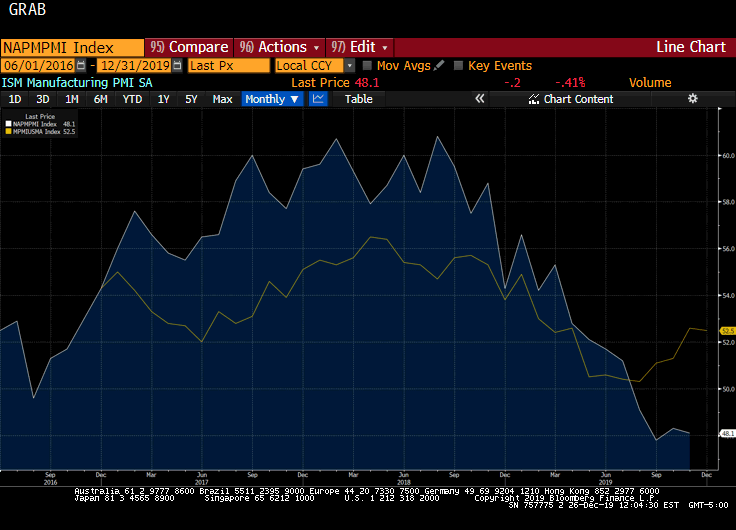 The year is winding down quietly, and the last week of 2019 is likely to be more of the same. The general mood of the market is quite different than a year ago. Then investors had marked down equities dramatically amid fears of what was perceived as a synchronized downturn. Now with additional monetary easing in the pipeline and renewed expansion of the Federal Reserve and European Central Bank’s balance sheets, risk appetites have been stoked.
The year is winding down quietly, and the last week of 2019 is likely to be more of the same. The general mood of the market is quite different than a year ago. Then investors had marked down equities dramatically amid fears of what was perceived as a synchronized downturn. Now with additional monetary easing in the pipeline and renewed expansion of the Federal Reserve and European Central Bank’s balance sheets, risk appetites have been stoked.
Previously, the notion that the central banks can tame the business cycle was dismissed as hubris. Now, however, investors seem to be acting as if the business cycle has not just been tamed but has all but disappeared. The combination of easing monetary policy, some countries turning to fiscal policy (e.g., Japan, the UK, Canada, New Zealand), and what appears to be an extended tariff truce between the two largest economies, lifts the animal spirits of risk-taking.
However, just as we were skeptical of the profound bearishness a year ago, we are concerned now that the bullish is exaggerated. The Japanese economy is contracting, and India is slowing. Japan’s preliminary manufacturing PMI was below the 50 boom/bust level for the eighth consecutive month. The final reading is not until January 5. India’s manufacturing PMI rose in November for the first time since July. The December reading is due January 2. A year ago, it was above 53. Now it will be fortunate to remain above 51.
The market was surprised by the tick up in China’s November PMI. Still, it did not presage an economic rebound as much as it signaled the economy may be stabilizing as the push for de-leveraging gives way renewed efforts to stimulate the economy. The November PMI gains are expected to be pared in December. China is not waiting for the legal trade document to be crafted. It continues to take measures that are consistent with the agreement and also in itself interest. For example, China’s soy imports from the US more than doubled to 2. 6 mln tons in November from 1.1 mln tons in October. Officials have suggested that easier financial conditions will be forthcoming, and the overnight repo fell to its lowest rate in a decade last week. A reduction in the required reserve ratios has long been expected and could take place any day.
While the eurozone’s service sector has shown some resiliency, manufacturing remains is poor health. The preliminary December reading was sobering given better German sentiment readings and ideas the worst is passed. It fell back to 45.9 from 46.9. It bottomed in September at 45.7. The final estimate will be issued on January 2, while the final services and composite reports are out the following week.
German is the European engine. Its preliminary December manufacturing PMI dropped to 43.4 from 44.1. It was at 51.5 at the end of 2018. However, assuming no revision in the final estimate, the Q4 average of 43.2 would be the first quarterly increase since Q4 17. With new national strikes in France over pension reform, the economy may be vulnerable. The preliminary manufacturing PMI eased to 50.3 from 51.7. It bottomed at 49.7 in March and July. The silver lining is that with no revision, the French manufacturing PMI would average 50.9 in Q4, the strongest quarter since Q3 18. Spain and Italy’s manufacturing was already in contraction in November, and it is expected to have deepened in December.
At her recent press conference, ECB President Lagarde pushed back against claims of the “Japanification of Europe” or that the negative interest rates have reached the “reversal point” where they are deterring activity by pointing to the growth in lending to households and non-financial businesses. These figures will be updated with the money supply report on January 3. M3 growth is expected to have ratcheted up to 5.7% from 5.6%, which puts it at its fastest pace since 2009.
| The preliminary UK manufacturing PMI also fell in December. It returned to the trough set in August at 47.4 from 48.9 in November. The Bloomberg survey found that most economists suspect this is exaggerated and forecast that the final report on January 2 to be revised slightly higher. The following day, the UK is expected to report November lending data, and consumer credit and mortgage lending and approvals slowed. Investors seem to want to look past the near-term economic weakness anticipating a lifting of uncertainty over Brexit to fuel investment, helped by election promises of fiscal stimulus. International fund managers are thought to be underweight UK assets, and this may be a source of sterling demand, many expect.
It has been difficult to get a strong handle on the US economy here in Q4. The Atlanta Fed says growth remains a little above what the Federal Reserve estimates to be its long-term sustainable path at 2.1%. The NY Fed’s model shows growth decelerating to 1.3%. Recall the conflicting signals in the manufacturing ISM, which rose (to 52.6 from 51.3) and the ISM, which fell (to 48.1 from 48.3) in November. The preliminary December PMI edged lower (to 52.5), and the ISM is expected to have firmed to 49, and it has not been above 50 since July. The Bloomberg chart depicts the divergence between the manufacturing PMI (yellow line) and the manufacturing ISM (white line). In addition to the PMI and ISM, several regional Federal Reserve branches provide manufacturing surveys from the regions are among the first high-frequency data for a new period. Four have already been released (New York, Philadelphia, Richmond, and Kansas City), and Dallas will join them in the week ahead. The new order component has fallen three of the four (Philadelphia was the exception. It rose to 9.4 from 8.4). Inventories increased in all but one (Kansas was the exception. It fell to -12 from -4). Separately, the government will report estimates for November wholesale and retail inventories, and they are expected to have edged higher. |
ISM Manufacturing PMI, 2016-2019 |
Trade has been an important focal point this year, and the US reports its November goods balance on December 30. Between the US becoming a net exporter of oil and gas, and economic nationalism driving foreign policy, one would have reason to expect improvement in the US trade balance. And there has been some improvement. Through October, the average monthly goods deficit has been $71.63 bln compared with $72.21 bln in the same 2018 period. However, it is statistically insignificant, and the underlying trend has been toward worsening. The average goods deficit in the first ten months of 2017 stood at $65.10 bln, and in 2016, it was about $60.76 bln.
December auto sales are expected to have slowed slightly from the 17.09 mln seasonally-adjusted annual pace in November. The average pace this year through last month is about 16.93 mln vehicles. In 2017 and 2018, the average pace through November was 17.11-17.12 mln.
The FOMC minutes from the uncontroversial December meeting and press conference will be released. The statement and updated forecasts seemed to be more confident that the midcourse correction had done the trick to boost the likelihood that the record-long expansion continues. The median estimate is that policy can stay on hold in 2020, and in any event, the bar to a rate hike is higher than the bar to easing. This, coupled with the Fed’s assessment that policy setting is currently tiled toward slight accommodation, sees supportive conditions for risk-taking.
The plumbing of the financial system came under new interest after the short-term refinancing rates jumped in September. The Fed has responded by conducting overnight repo operations term repos (longer than overnight), and the purchase of $60 bln a month in T-bills. Despite some year-end pressures still evident, the Fed’s moves seem to have balanced the conflicting policy objectives. The last three term operations that provided funding for the year-end turn were undersubscribed. The Federal Reserve will make as much as another $260 bln of liquidity available next week. The Federal Reserve is wrestling with reserves in the post-crisis era where excess reserves replaced a scarcity, but regulatory demands also impinge, and the low rates also shape the incentive structure. We continue to see this as an issue about the transmission of policy more than monetary policy itself.
Full story here Are you the author? Previous post See more for Next postTags: China,EMU,federal-reserve,newsletter,U.K.,US


















